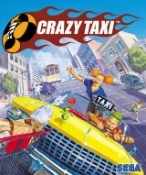Crazy Taxi Review
|
|
See PixlBit's Review Policies

On 12/26/2010 at 10:36 PM by Jason Ross Earn thousands of dollars in minutes from the comfort of your own car! |

For anyone who's ever driven in a traffic jam and felt the urge to scream out in agony, vent your frustrations with Crazy Taxi.
Let's get this out of the way: Crazy Taxi, as it's available on PSN and XBLA is a modified port of a Dreamcast port of a now-classic arcade game. The Dreamcast port added in a second city to chauffeur customers around town, as well as the “Crazy Box” mode, which contains sixteen driving tests to hone and expand players' mad taxi skills. The PSN and XBLA version of Crazy Taxi is much like the Dreamcast version, with the extra city, time modes, and Crazy Box.

That said, there's a few issues with the port that fans of the original game probably won't enjoy, though newcomers won't even notice them. The obvious changes? Music! Crazy Taxi's music has been changed, for licensing purposes. No longer are there any vocal tracks; everything has been replaced with some instrumental quick punk-rockish music. Beyond that, several locations have been re-branded, too! Gone is the Pizza Hut, KFC, Levi's store, and Tower Records. In their places sit a pizza parlor, Fried Southern Chicken, a clothing store, and a record store. Essentially, the charm of in-game marketing is removed from the title.
For me, both changes remove a bit of Crazy Taxi's personality and also reduce some of the cheese factor. For a zany, wild game like Crazy Taxi, it’s not a good thing. Unfortunately, I noticed one other change: An imbalance in the sound levels. Read: Passengers in Crazy Taxi don't shout as loud. Even maxing out the “Sound Effects” option in the menu didn't quite get the people I was cabbing all over the place as loud as they begin on default settings with earlier ports. This alteration is disappointing, through and through.

Regardless, the Crazy Taxi experience is a must-have. Flying down streets, weaving through traffic, dashing and boosting on straightaways; the feeling, excluding the above changes, remains. There's a city littered full of people willing to pay hundreds in cab fare to speed around town to several destinations. Both cities still give off the San Francisco vibe of the original, with trolleys, a busy, complex downtown area, and sidewalks cluttered with pedestrians who always dive out of the way just in time. The breaks and gas are mapped to the shoulder buttons and make full use of the controller’s force-sensitive triggers to add a slight element of realism to the title. Crazy Taxi, for most, is best played a few turns at a time, with a crowd of people laughing at the driving prowess—or lack thereof—of whoever is playing.
At its roots, Crazy Taxi remains an arcade game. For better or for worse, characteristics of its money-guzzling origins still show. Advanced maneuvers, like speedy “Crazy Dashes” or even variations of “Crazy Drifts,” are a bit too complex for the hectic streets of the city for any sort of novice. Far worse, the two cities in the game seem to use different algorithms to direct the arrow that points to a passenger's destination.

With the arcade city, the arrow never seemed to miss a chance to lead me directly into a building, which is frustrating, but ultimately can be navigable. In the home-version exclusive city, the arrow would often point me down the street, but at every fork, it would become unreliable, often even aiming back at the path I came from upon choosing either path, as if to say I picked the wrong one. I'd change direction and head down the opposite road, but again, the arrow would point backwards. Ultimately, the best option is to ignore the arrow and memorize passenger destinations, something much easier said than done.
Strict time-limits on the main game's mode also mean that all but the best players will spend only two or three minutes with any arcade-style session. Fortunately, through the options menu, it is possible to boost the game's starting time and the reward for speedy transfer of passengers. Without that option, Crazy Taxi's difficulty, for a novice, would probably be a hair overwhelming to experience a lot of the wacky fun that can be had.

Crazy Box seems to be half an attempt to teach the abilities mentioned above, but the pairing of brief time limits with a lack of instructions makes for a mode that feels too difficult; Crazy Taxi drivers would be better off taking the ten minute cabbing option and looking up a how-to guide online to learn and master things like the “Limiter Cut,” to reach unprecedented speeds. The Crazy Box just didn't cut it as any sort of tutorial, with paltry, unclear directions for the cab’s abilities and a lack of example videos.
Surprisingly, in contrast Crazy Taxi's arcade origins, there's quite a lot of selection to be had. Through the use of codes, it's possible to alter around the starting location in each city, also altering passenger placements and destinations. Though it's a little bit of a stretch, one could say the game offers something akin to four cities, given the placement differences. Even more, this version of the game has online leaderboards to track the scores of any individual player.
Overall, Crazy Taxi is the same game it was several years ago. The gameplay, itself, holds up well, but in this port, some of the game's character has been removed. For ten dollars, it makes a great buy, especially if it can be played in the presence of friends. While moving from a novice to a master can be a bit difficult, even frustrating, approaching the game is still very easy, likely something anyone can and will want to do.










Comments